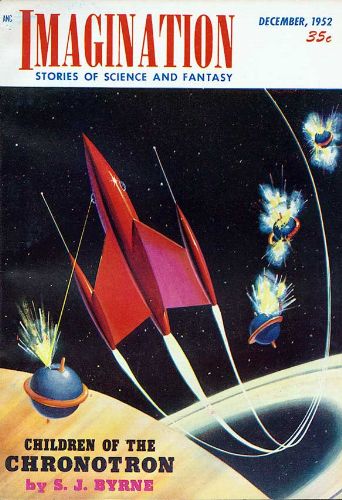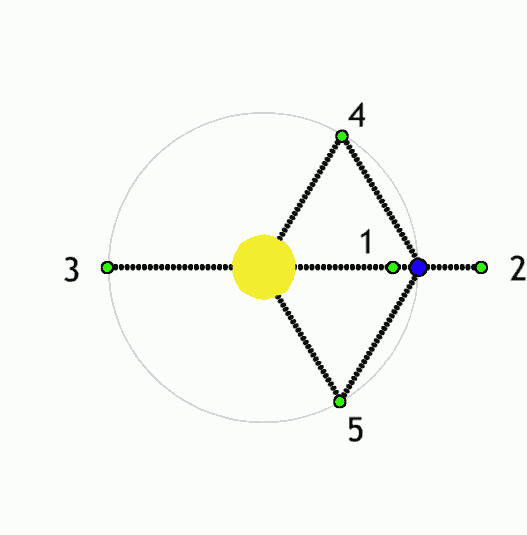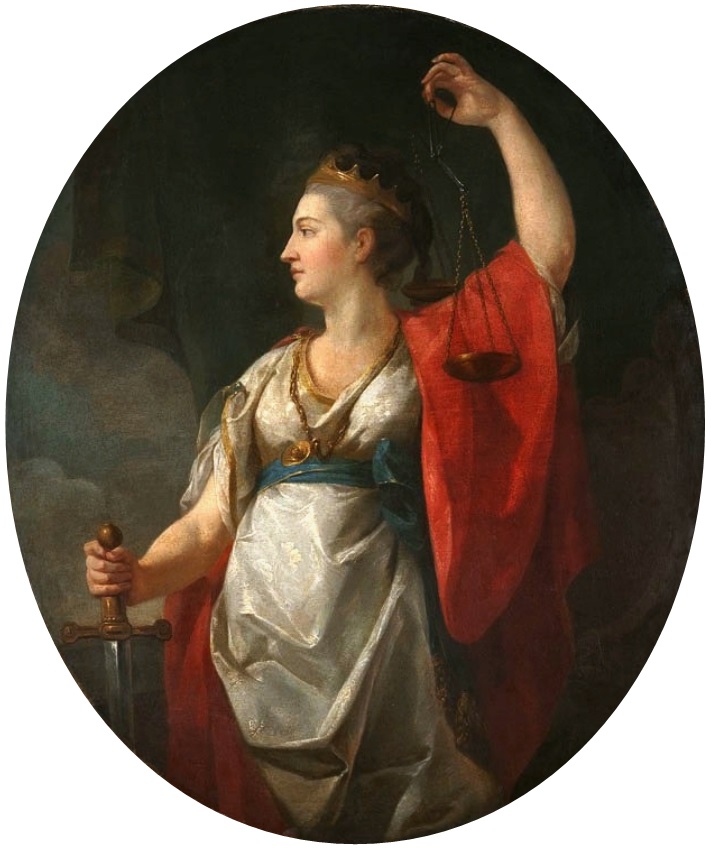|
Lissajous Orbit
In orbital mechanics, a Lissajous orbit (), named after Jules Antoine Lissajous, is a quasi-periodic orbital trajectory that an object can follow around a Lagrangian point of a three-body system with minimal propulsion. Lyapunov orbits around a Lagrangian point are curved paths that lie entirely in the plane of the two primary bodies. In contrast, Lissajous orbits include components in this plane and perpendicular to it, and follow a Lissajous curve. Halo orbits also include components perpendicular to the plane, but they are periodic, while Lissajous orbits are usually not. In practice, any orbits around Lagrangian points , , or are dynamically unstable, meaning small departures from equilibrium grow over time. As a result, spacecraft in these Lagrangian point orbits must use their propulsion systems to perform orbital station-keeping. Although they are not perfectly stable, a modest effort of station keeping keeps a spacecraft in a desired Lissajous orbit for a long time. ... [...More Info...] [...Related Items...] OR: [Wikipedia] [Google] [Baidu] |
Wilkinson Microwave Anisotropy Probe
The Wilkinson Microwave Anisotropy Probe (WMAP), originally known as the Microwave Anisotropy Probe (MAP and Explorer 80), was a NASA spacecraft operating from 2001 to 2010 which measured temperature differences across the sky in the cosmic microwave background (CMB) – the radiant heat remaining from the Big Bang. Headed by Professor Charles L. Bennett of Johns Hopkins University, the mission was developed in a joint partnership between the NASA Goddard Space Flight Center and Princeton University. The WMAP spacecraft was launched on 30 June 2001 from Florida. The WMAP mission succeeded the Cosmic Background Explorer, COBE space mission and was the second medium-class (MIDEX) spacecraft in the NASA Explorer program. In 2003, MAP was renamed WMAP in honor of cosmologist David Todd Wilkinson (1935–2002), who had been a member of the mission's science team. After nine years of operations, WMAP was switched off in 2010, following the launch of the more advanced Planck (spacecraft ... [...More Info...] [...Related Items...] OR: [Wikipedia] [Google] [Baidu] |
Genesis (spacecraft)
''Genesis'' was a NASA sample-return mission, sample-return probe that collected a sample of solar wind particles and returned them to Earth for analysis. It was the first NASA sample-return mission to return material since the Apollo program, and the first to return material from beyond the orbit of the Moon. ''Genesis'' was launched on August 8, 2001, and the sample return capsule crash-landed in Utah on September 8, 2004, after a design flaw prevented the deployment of its drogue parachute. The crash contaminated many of the sample collectors. Although most were damaged, some of the collectors were successfully recovered. The ''Genesis'' science team demonstrated that some of the contamination could be removed or avoided, and that the solar wind particles could be analyzed using a variety of approaches, achieving all of the mission's major science objectives. Objectives The mission's primary science objectives were: * To obtain precise solar isotope, isotopic abundances o ... [...More Info...] [...Related Items...] OR: [Wikipedia] [Google] [Baidu] |
Andy Weir
Andrew Weir (; born June 16, 1972) is an American novelist. His 2011 novel '' The Martian'' was adapted into the 2015 film of the same name directed by Ridley Scott. He received the John W. Campbell Award for Best New Writer in 2016 and his 2021 novel '' Project Hail Mary'' was a finalist for the 2022 Hugo Award for Best Novel. Early life Weir was raised in Milpitas, California. His father, John Weir, was a physicist at Sandia National Laboratories, and his mother was an electrical engineer. He was an only child, and his parents divorced when he was eight. Weir grew up reading classic science fiction such as the works of Arthur C. Clarke and Isaac Asimov. At the age of 15, he began working as a computer programmer for Sandia. After high school, Weir studied computer science at the University of California, San Diego, although he did not graduate. He worked as a programmer for several software companies, including AOL, Palm, MobileIron, and Blizzard, where he worked on th ... [...More Info...] [...Related Items...] OR: [Wikipedia] [Google] [Baidu] |
Artemis (novel)
''Artemis'' is a 2017 science fiction novel by American writer Andy Weir. It takes place in the late 2080s in Artemis, the first and so far only city on the Moon. It follows the life of porter and smuggler Jasmine "Jazz" Bashara as she gets caught up in a conspiracy for control of the city. The audiobook edition (published by Amazon.com) is narrated by Rosario Dawson. Plot In Artemis, the first city on the Moon, porter and part-time smuggler Jasmine "Jazz" Bashara is offered an opportunity by a regular client, wealthy businessman Trond Landvik, to assist him with a new business venture. While meeting with Trond, Jazz briefly encounters an associate of his named Jin Chu who attempts to conceal a case marked with the name ZAFO. Trond intends to take over Sanchez Aluminum, which currently enjoys a lucrative permanent contract with the city for free energy in exchange for providing the city's entire oxygen supply as a by-product from aluminum production. Trond asks Jazz to sabotage ... [...More Info...] [...Related Items...] OR: [Wikipedia] [Google] [Baidu] |
Stephen Baxter (author)
Stephen Baxter (born 13 November 1957) is an English hard science fiction author. He has degrees in mathematics and engineering. Writing style Strongly influenced by science fiction pioneer H. G. Wells, Baxter has been vice-president of the international H. G. Wells Society since 2006. His fiction falls into three main categories of original work plus a fourth category, extending other authors' writing; each has a different basis, style, and tone. Baxter's "Future history, Future History" mode is based on research into hard science fiction, hard science. It encompasses the ''Xeelee Sequence'', which consists of nine novels (including the ''Destiny's Children'' trilogy and Vengeance/Redemption duology that is set in alternate timeline), plus three volumes collecting the 52 short pieces (short stories and novellas) in the series, all of which fit into a single timeline stretching from the Big Bang singularity of the past to his ''Timelike Infinity'' (1993) singularity of the fu ... [...More Info...] [...Related Items...] OR: [Wikipedia] [Google] [Baidu] |
Arthur C
Arthur is a masculine given name of uncertain etymology. Its popularity derives from it being the name of the legendary hero King Arthur. A common spelling variant used in many Slavic, Romance, and Germanic languages is Artur. In Spanish and Italian it is Arturo. Etymology The earliest attestation of the name Arthur is in the early 9th century Welsh-Latin text '' Historia Brittonum'', where it refers to a circa 5th century Romano-British general who fought against the invading Saxons, and who later gave rise to the famous King Arthur of medieval legend and literature. A possible earlier mention of the same man is to be found in the epic Welsh poem '' Y Gododdin'' by Aneirin, which some scholars assign to the late 6th century, though this is still a matter of debate and the poem only survives in a late 13th century manuscript entitled the Book of Aneirin. A 9th-century Breton landowner named Arthur witnessed several charters collected in the '' Cartulary of Redon''. The Irish ... [...More Info...] [...Related Items...] OR: [Wikipedia] [Google] [Baidu] |
Sunstorm (novel)
''Sunstorm'' is a 2005 science fiction novel co-written by British writers Arthur C. Clarke and Stephen Baxter. It is the second book in the series '' A Time Odyssey''. The books in this series are often likened to the '' Space Odyssey'' series, although the ''Time Odyssey'' novels ostensibly deal with time where the ''Space Odyssey'' novels dealt with space. The first book in the series was '' Time's Eye''. Plot summary ''Sunstorm'' opens with the last chapter of '' Time's Eye'' as its initial chapter, and Bisesa Dutt is in London, reunited with her daughter. It is 9 June 2037, the day after her helicopter was shot down in the North Western Frontier Province of Pakistan. The five years that she spent on Mir, an alternate Earth, are now only memories (though the fact that her body has aged five years since 8 June 2037, will eventually serve as some confirmation of her story). In the meantime, a major solar event occurs on 9 June, disrupting virtually all of the Ear ... [...More Info...] [...Related Items...] OR: [Wikipedia] [Google] [Baidu] |
Science Fiction
Science fiction (often shortened to sci-fi or abbreviated SF) is a genre of speculative fiction that deals with imaginative and futuristic concepts. These concepts may include information technology and robotics, biological manipulations, space exploration, time travel, Parallel universes in fiction, parallel universes, and extraterrestrials in fiction, extraterrestrial life. The genre often explores human responses to the consequences of projected or imagined scientific advances. Science fiction is related to fantasy (together abbreviated wikt:SF&F, SF&F), Horror fiction, horror, and superhero fiction, and it contains many #Subgenres, subgenres. The genre's precise Definitions of science fiction, definition has long been disputed among authors, critics, scholars, and readers. Major subgenres include hard science fiction, ''hard'' science fiction, which emphasizes scientific accuracy, and soft science fiction, ''soft'' science fiction, which focuses on social sciences. Other no ... [...More Info...] [...Related Items...] OR: [Wikipedia] [Google] [Baidu] |
Halo Orbit
A halo orbit is a periodic, non-planar orbit associated with one of the L1, L2 or L3 Lagrange points in the three-body problem of orbital mechanics. Although a Lagrange point is just a point in empty space, its peculiar characteristic is that it can be orbited by a Lissajous orbit or by a halo orbit. These can be thought of as resulting from an interaction between the gravitational pull of the two planetary bodies and the Coriolis and centrifugal force on a spacecraft. Halo orbits exist in any three-body system, e.g., a Sun–Earth–orbiting satellite system or an Earth–Moon–orbiting satellite system. Continuous "families" of both northern and southern halo orbits exist at each Lagrange point. Because halo orbits tend to be unstable, station-keeping using thrusters may be required to keep a satellite on the orbit. Most satellites in halo orbit serve scientific purposes, for example space telescopes. Definition and history Robert W. Farquhar first used the name " ... [...More Info...] [...Related Items...] OR: [Wikipedia] [Google] [Baidu] |
Chang'e 4
Chang'e 4 (; ) is a robotic spacecraft mission in the Chinese Lunar Exploration Program of the CNSA. It made a soft landing on the far side of the Moon, the first spacecraft to do so, on 3 January 2019. A communication relay satellite, , was first launched to a halo orbit near the Earth–Moon L2 point in May 2018. The robotic lander and '' Yutu-2'' () rover were launched on 7 December 2018 and entered lunar orbit on 12 December 2018, before landing on the Moon's far side. On 15 January it was announced that seeds had sprouted in the lunar lander's biological experiment, the first plants to sprout on the Moon. The mission is the follow-up to Chang'e 3, the first Chinese landing on the Moon. The spacecraft was originally built as a backup for Chang'e 3 and became available after Chang'e 3 landed successfully in 2013. The configuration of Chang'e 4 was adjusted to meet new scientific and performance objectives. Like its predecessors, the mission is named after Chang'e, ... [...More Info...] [...Related Items...] OR: [Wikipedia] [Google] [Baidu] |
Queqiao Relay Satellite
''Queqiao'' relay satellite (), is the first of the pair of communications relay and radio astronomy satellites for the Chinese Lunar Exploration Program. The China National Space Administration (CNSA) launched the Queqiao relay satellite on 20 May 2018 to a halo orbit around the Earth–Moon L2 Lagrangian point Queqiao is the first communication relay and radio astronomy satellite at this location. The name ''Queqiao'' ("Magpie Bridge") was inspired by and came from the Chinese tale ''The Cowherd and the Weaver Girl''. Design and development Queqiao was designed to function as a communication relay for the Chang'e 4 mission to the far side of the Moon, as well as a deep space radio astronomy observatory for the Chinese space program. Direct communication with Earth is impossible on the far side of the Moon, since transmissions are blocked by the Moon. Communications must go through a communications relay satellite, which is placed at a location that has a clear view of both ... [...More Info...] [...Related Items...] OR: [Wikipedia] [Google] [Baidu] |
THEMIS
In Greek mythology and religion, Themis (; ) is the goddess and personification of justice, divine order, law, and custom. She is one of the twelve Titan children of Gaia and Uranus, and the second wife of Zeus. She is associated with oracles and prophecies, including the Oracle of Delphi. Name ''Themis'' means "divine law" rather than human ordinance, literally "that which is put in place", from the Greek verb ''títhēmi'' ( τίθημι), meaning "to put." To the ancient Greeks she was originally the organizer of the "communal affairs of humans, particularly assemblies." Moses Finley remarked of ''themis'', as the word was used by Homer in the 8th century BCE, to evoke the social order of the 10th- and 9th-century Greek Dark Ages: Finley adds, "There was ''themis''—custom, tradition, folk-ways, ''mores'', whatever we may call it, the enormous power of 'it is (or is not) done'." In the ''Hymn to Apollo'', Themis is referred to as " Ichnaea", meaning "Tracker". Descr ... [...More Info...] [...Related Items...] OR: [Wikipedia] [Google] [Baidu] |





